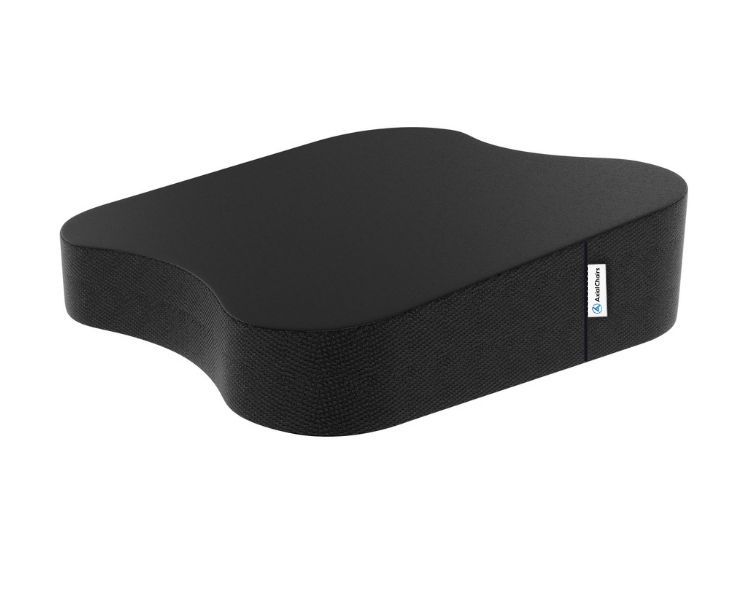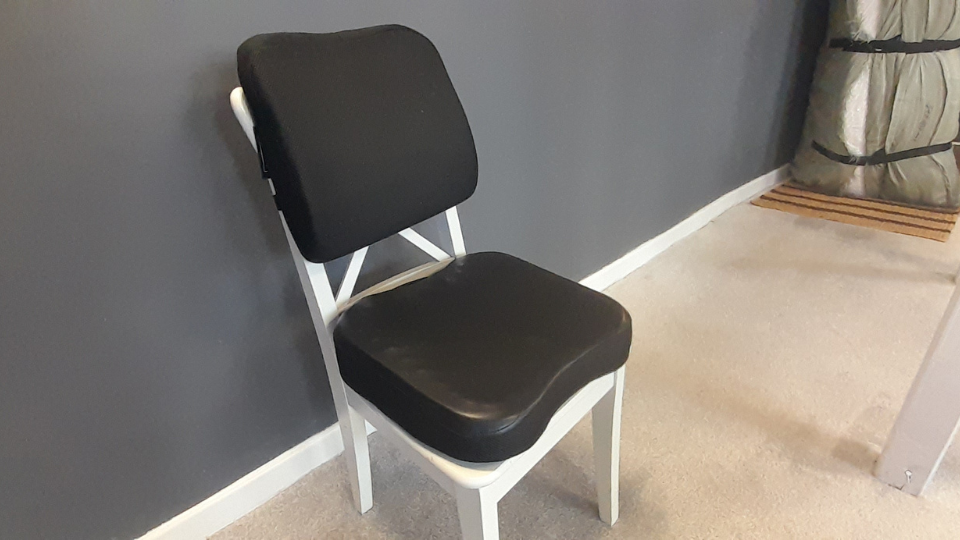As a physician, I understand the importance of properly supporting your back when sitting or standing. While there are many products out there that claim to provide lumbar support, it can be hard to know whether they actually do what they say they will. That is why today, I am here to discuss the pros and cons of lumbar supports – so you can decide if this is something that may be beneficial for you.
As a general rule, lumbar support can be good for those who suffer from lower back pain as it helps maintain a proper spinal curvature and reduces pressure on the lower back. However, excessive use of lumbar support can lead to weakened back muscles and decreased flexibility, so it is important to strike a balance and not rely solely on lumbar support for spinal health.
As a practitioner with over 30 years of practice, and training as an ergonomist and author on sitting, I’m well-equipped to provide valuable insights. My contributions to this field have been well-received, with TV appearances, my Youtube channel, and a successful Kickstarter campaign for my ergonomic seat cushions. If you’re searching for answers, I’m confident that I can offer meaningful guidance.
Best Seat Cushion for SupportDoctor's Recommendation
Black Friday Offer!
Get 35% off Orthopedic Seat Cushion
Product DetailsResearch-based Design
Recommended ForBack Discomfort
Video Guide
Video Guide
Does Lumbar Support Really Help?
From my years of clinical experience, I can tell you that lumbar support can, indeed, be a helpful companion. When used correctly, it encourages an upright posture, reducing the strain on your lower back muscles and promoting better spinal alignment.
Think of it like the gentle nudge from your grandmother reminding you to sit up straight at the dinner table. It’s not that she enjoyed nagging, but she knew the benefits of good posture. Similarly, your lumbar support is that non-nagging nudge your back needs.
Can Lumbar Support Be Shockingly Detrimental?
Like any good thing, too much or misuse can cause problems. Imagine eating your favorite ice cream every day for breakfast, lunch, and dinner. Sounds heavenly at first, but soon, you’ll probably be sick of it and feeling less than stellar.
The same principle applies to lumbar support. Over-reliance can lead to weakened core muscles since the support is doing most of the work. It’s a bit like a cheat day that turned into a cheat year.
Lumbar Cushion: Poor Habits
As a seasoned chiropractor, I can’t stress enough how much I resonate with your struggles when it comes to poor lumbar support habits. I’ve seen countless patients walk into my clinic with the telltale sign of a low back ache, a grimace that immediately says, “pain read all over my face.” And let me tell you, it’s not a pretty sight.
From my years of clinical experience, I’ve found out that the root of the issue often lies in our home office setups. Yes, those seemingly harmless chairs that we spend hours on end perched upon. They might feel good initially, but without adequate back support, we’re setting ourselves up for a world of discomfort. “Why is that?” you might ask. Well, here’s the thing: a good lumbar support helps promote good posture, acting like your personal cheerleader, encouraging your spine to maintain its natural curvature.
Now, I know how you feel. A lumbar pillow might sound like a magical fix, but here’s the caveat – if your lumbar support is too high, it can push your spine into an awkward position. This isn’t just wrong; it’s a shortcut to more pain. The aim should always be to find the ‘Goldilocks’ spot – not too high, not too low – just right.
What’s fascinating is that one study found that adding a bit of bulk significantly decreased lumbar flattening during sitting. Yes, you heard it right, your comfy cushion can be your best ally in maintaining spinal alignment and a balanced and strong core, which is the central mechanism for sitting without causing back pain.
And let’s face it, good lumbar support feels good because it gives relief to those nagging aches and pains. It’s not just about prevention, but it can also provide relief from back pain that’s already there.
So, What’s the Secret Sauce?
Well, after years of treating various back issues, I’ve come to realize that balance is key. Just like you wouldn’t rely solely on that ice cream diet (tempting as it may be), don’t rely only on lumbar support.
Pair it with regular core strengthening exercises to maintain a balanced and strong core. This way, your body will get accustomed to the correct posture, and your muscles will be strong enough to maintain it. It’s like having your ice cream and eating it too – without the stomachache!
The Role of Spinal Alignment
Spinal alignment is like the conductor of an orchestra. If the conductor is offbeat, the whole performance suffers. It’s the same with your body. Poor alignment can lead to a symphony of discomfort, including back pain, neck strain, and even headaches.
Lumbar support can help you maintain this alignment when sitting, but don’t forget the importance of movement. Regular breaks from sitting, gentle stretching, and good old-fashioned walks can do wonders for your spinal alignment.
Best Seat Cushion for SupportAxial Ergonomic Seat Cushion® | Seat Chair Wedge
Quick Guide: A 30-Second Summary

All Day Comfort & Support
Product Name
Axial Designs™ Seat Cushion
Price
$149
Warranty
1 Year
Type
Posture Wedge
Top Layer
100% Natural Latex (Molded)
Bottom Layer
High-Density Foam
Top Material
Isometric Grippy Vegan Leather
Bottom Material
Non-Slip Material
Side Material
3D Breathable Fabric
How Can I Make My Chair Ergonomic?
When it comes to creating an ergonomic workstation, there are a number of factors to consider. One of the most important is to make sure your chair is properly adjusted to fit your body. This can be done in several ways, such as adding an ergonomic seat cushion and lumbar support. These inserts will take pressure off of your back and legs, helping to provide comfort and improve posture during extended periods at the desk. Other considerations include keeping your feet flat on the ground and maintaining good spacing between your chair and desk. With these tips in mind, you can transform any ordinary office chair into an ergonomic masterpiece that will help protect your health and well-being for years to come.
Ergonomic Seat Cushion
You can use the ergonomic seat wedge (above) to align your spine and improve balance. This will help strengthen core muscles while relieving tension in other parts of our bodies, for example, our shoulders and neck! As well, it’s easier on both your hips and knees if you’re sitting upright because this position works for more muscle groups at once as opposed to sitting back comfortably against something soft – which is precisely what happens when people do these subconscious activities at work without realizing how stress-inducing they were.
I explain the concept of my ergonomic design on a TV show HERE
The Role of Lumbar Support
Lumbar support plays a vital role in maintaining the health and wellness of our spine. As a chiropractor, I often stress the importance of proper support to our lower back, especially when we spend long hours sitting, whether at work or during our commute. Lumbar support can help alleviate the strain on our lower back muscles and ligaments, reducing the risk of developing chronic pain and discomfort.
The Benefits: Lumbar Support and Posture
The benefits of lumbar support are plentiful. It can help maintain the natural ‘S’ curve of our spine while sitting, which is crucial for proper posture. Good posture not only helps in avoiding musculoskeletal problems but also enhances breathing, circulation, and even our mood. Lumbar supports, whether in the form of ergonomic chairs or separate cushions, can be an essential tool for those struggling with maintaining good posture.
All Day Comfort & Support
How a Back Cushion Can Alleviate Pain
Chronic back pain is often the result of prolonged poor posture or strain on the lower back. Lumbar support can help rectify this by promoting a healthier alignment and reducing the pressure on these pain points. For many of my patients, the introduction of lumbar support into their daily routines has led to a significant reduction in their pain levels and an overall improvement in their quality of life.
I’ve written a complete hands-on review about the best sitting position for sciatica, and here is what I tested best with my sciatica patients.
Office Chair Lumbar Support and Prevention
It’s not just about pain relief; lumbar support is also about prevention. By supporting the lower back and promoting correct spinal alignment, we can mitigate the risk of future back problems. For those with a history of back issues, or professions that require long hours of sitting or heavy lifting, lumbar support can be an effective preventative measure.
The Flip Side: Overreliance on Lumbar Support for Office Chairs
However, while lumbar support can offer numerous benefits, it’s not without its potential downsides. Overreliance on lumbar support can lead to a weakening of the core muscles, which are essential for maintaining our natural posture. Our bodies are designed for movement, and relying too heavily on external supports can result in the underuse of our intrinsic musculature.
Striking a Balance
Striking a balance is key. Lumbar support should not replace the need for regular movement and exercise, particularly exercises that strengthen the core and lower back muscles. My advice to patients is always to use lumbar support as a part of a comprehensive approach to spinal health, which includes regular chiropractic care, exercise, and proper nutrition.
Remember, every individual is unique, and what works for one person may not work for another. So, always seek professional advice before making any major changes to your health regime.
(Note: Always consult your healthcare provider or a professional chiropractor for personalized advice and treatment.)
Black Friday: 35% Off Today
Typical Delivery 1-3 Days
FAQ’s
Why Does Lumbar Support Hurt My Back?
Ah, the age-old question I hear echoing through my clinic: “Doc, why does this lumbar support feel like a medieval torture device?” Trust me, I feel your pain. Literally. I’ve tested these devices myself. From my clinical experience, the issue usually arises from incorrect use or a one-size-fits-all mindset.
The purpose of lumbar support is to maintain the natural curve of your lower spine, known as the lordotic curve. When that’s out of whack, your back screams out in protest. The problem can often be that lumbar supports aren’t always designed with this unique curve in mind, causing an unnatural pressure point that makes your back feel like it’s wrestling a honey badger. The key is in finding a support that’s right for you and your spine’s unique signature curve.
Where Should Lumbar Support Be On Your Back?
So, you’ve made it past the first hurdle and invested in a lumbar support. Congratulations! But where should it sit? If you’ve ever played musical chairs with your lumbar support, you’re not alone. I’ve seen patients place it everywhere from the nape of their neck to their tailbone, looking like they’re gearing up for a backpacking trip.
The sweet spot, my friends, is your lower back, right in the small of your back. The aim here is to fill the gap between your back and the chair when you’re sitting, maintaining that crucial lordotic curve. Think of it as a supportive hand cradling your lower back.
How to Position Lumbar Support on Chair?
Now that we’ve found the elusive sweet spot, let’s talk about securing the support to your chair. Some of you might be thinking, “This is a no-brainer,” but I can’t tell you how many times I’ve walked into my office to find a lumbar cushion hanging off the chair like a lost puppy.
Fasten your lumbar support securely to the chair so that it’s positioned in the lower third of the chair back. This will ensure that it hits the small of your back just right. Make sure it’s snug and won’t slide down when you sit. Consider it your trusty sidekick, always there to save the day (and your back).
Do I Need a Lumbar Support Belt?

Now onto lumbar support belts. Some of my patients swear by them like they’ve found the holy grail. Others, not so much. The lumbar support belt works by reducing the load on your lower back, promoting a better posture, and offering some stability.
But here’s the catch – it’s not a permanent solution. Think of it as a temporary helper during heavy lifting or prolonged standing. Over-reliance can lead to weaker back muscles over time because, well, your muscles get lazy if they’re not used. And we don’t want lazy muscles, do we?
Does Lumbar Cushion Help Lower Back Pain?
The million-dollar question: does lumbar support actually help with lower back pain? From my years of experience in the trenches, the answer is a resounding yes – but with a caveat. It’s not a magic cure-all. Think of it more as part of your back health toolkit, along with regular exercise, a strong core, and good posture.
Remember, every back is unique, just like every fingerprint. What works for one person may not work for another. So, it’s crucial to listen to your body and make adjustments as needed. As a chiropractor, my goal is to help you find the balance that works for you and your spine. Because a happy spine makes for a happy life, and who doesn’t want that?
Summary
In conclusion, lumbar support is a very underrated yet important factor in choosing the right office chair. It is important to note that lumbar support ensures your back is properly aligned and can help you feel more comfortable. Moreover, adjustable lumbar support curbs compression of the intervertebral discs and spinal nerves, improving overall posture during extended seating periods and helping to ward off injury.
When choosing an office chair, it’s essential to ensure there’s a good mix of ergonomics, including proper lumbar support and adjustable heights. By taking this approach, one can enhance comfort levels while ensuring healthy postural habits that protect against further injuries over time. So if you’re in pain or simply thinking about investing in a new office chair – consider lumbar support as an option – it could mean all the difference!







